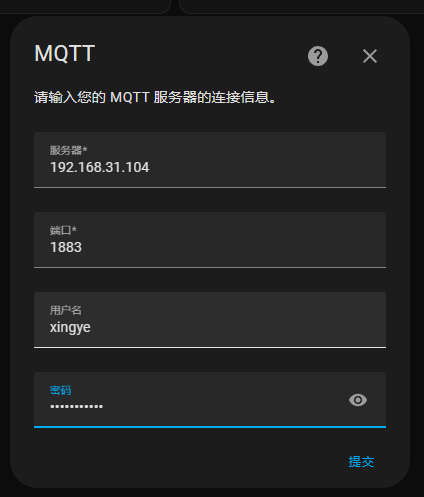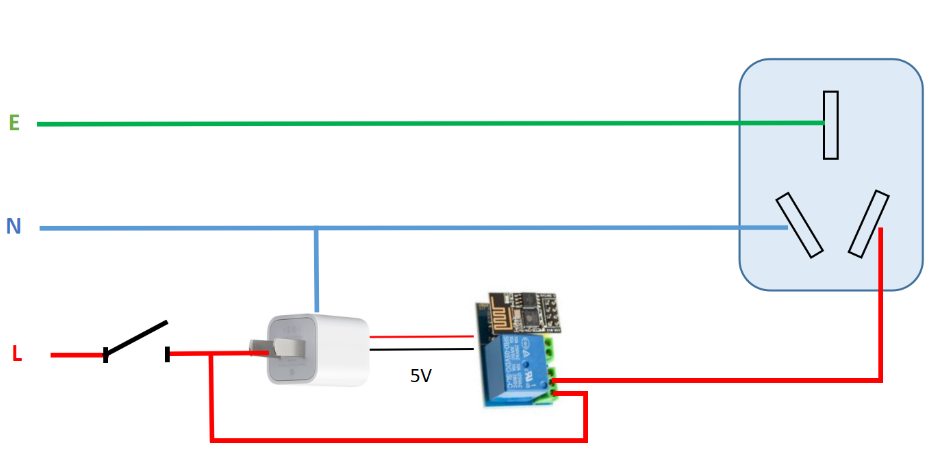
MicroPython的代码,放在boot.py
import network
import urequests
import machine
import utime,gc
#from umqtt.simple import MQTTClient
import simple #因为ESP01S内置没有umqtt.simple模块,所以手动添加
ap = network.WLAN(network.AP_IF)
ap.active(False) #我们使用mqtt来通信,用不到esp8266的热点,关掉它
station = network.WLAN(network.STA_IF)
station.active(True)
station.connect('OPEN', '12345678')
while not station.isconnected():
pass
utime.sleep(1)
pin0 = machine.Pin(4, machine.Pin.OUT) #ESP01S加继电器默认是gpio0
pin0.value(1) #初始保证继电器是关着的
SERVER = '192.168.31.104' #MQTT服务器IP
PORT = 1883 #MQTT服务器端口
# 客户端 ID,通常是设备的名称或唯一标识符
CLIENT_ID = 'chapai'
# 创建 MQTTClient 对象并连接到代理服务器,如果没设置用户名和密码则可删除掉下面user和password
# client = simple.MQTTClient(CLIENT_ID, SERVER, port=PORT)
client = simple.MQTTClient(CLIENT_ID, SERVER, port=PORT,user="admin",password ="password")
client.connect()
# 发布主题的消息
client.publish('chapai','esp8266Connected') #前面是主题,后面是消息,这条消息来验证esp8266是否成功连接到 服务器
# 订阅主题
def sub_cb(topic, msg): #这个函数表示收到mqtt消息后会做什么
print((topic, msg))
if topic == b'chapai':
if msg == b'on': #如果接收到消息是on,则把电平降低,继电器打开
pin4.value(0)
gc.collect()
elif msg == b'off': #如果接收到消息是off,则把电平升高,继电器关闭
pin4.value(1)
gc.collect()
client.set_callback(sub_cb)
client.subscribe('chapai')
while True:
client.wait_msg()
simple.py
import usocket as socket
import ustruct as struct
from ubinascii import hexlify
class MQTTException(Exception):
pass
class MQTTClient:
def __init__(
self,
client_id,
server,
port=0,
user=None,
password=None,
keepalive=0,
ssl=False,
ssl_params={},
):
if port == 0:
port = 8883 if ssl else 1883
self.client_id = client_id
self.sock = None
self.server = server
self.port = port
self.ssl = ssl
self.ssl_params = ssl_params
self.pid = 0
self.cb = None
self.user = user
self.pswd = password
self.keepalive = keepalive
self.lw_topic = None
self.lw_msg = None
self.lw_qos = 0
self.lw_retain = False
def _send_str(self, s):
self.sock.write(struct.pack("!H", len(s)))
self.sock.write(s)
def _recv_len(self):
n = 0
sh = 0
while 1:
b = self.sock.read(1)[0]
n |= (b & 0x7F) << sh
if not b & 0x80:
return n
sh += 7
def set_callback(self, f):
self.cb = f
def set_last_will(self, topic, msg, retain=False, qos=0):
assert 0 <= qos <= 2
assert topic
self.lw_topic = topic
self.lw_msg = msg
self.lw_qos = qos
self.lw_retain = retain
def connect(self, clean_session=True):
self.sock = socket.socket()
addr = socket.getaddrinfo(self.server, self.port)[0][-1]
self.sock.connect(addr)
if self.ssl:
import ussl
self.sock = ussl.wrap_socket(self.sock, **self.ssl_params)
premsg = bytearray(b"\x10\0\0\0\0\0")
msg = bytearray(b"\x04MQTT\x04\x02\0\0")
sz = 10 + 2 + len(self.client_id)
msg[6] = clean_session << 1
if self.user is not None:
sz += 2 + len(self.user) + 2 + len(self.pswd)
msg[6] |= 0xC0
if self.keepalive:
assert self.keepalive < 65536
msg[7] |= self.keepalive >> 8
msg[8] |= self.keepalive & 0x00FF
if self.lw_topic:
sz += 2 + len(self.lw_topic) + 2 + len(self.lw_msg)
msg[6] |= 0x4 | (self.lw_qos & 0x1) << 3 | (self.lw_qos & 0x2) << 3
msg[6] |= self.lw_retain << 5
i = 1
while sz > 0x7F:
premsg[i] = (sz & 0x7F) | 0x80
sz >>= 7
i += 1
premsg[i] = sz
self.sock.write(premsg, i + 2)
self.sock.write(msg)
# print(hex(len(msg)), hexlify(msg, ":"))
self._send_str(self.client_id)
if self.lw_topic:
self._send_str(self.lw_topic)
self._send_str(self.lw_msg)
if self.user is not None:
self._send_str(self.user)
self._send_str(self.pswd)
resp = self.sock.read(4)
assert resp[0] == 0x20 and resp[1] == 0x02
if resp[3] != 0:
raise MQTTException(resp[3])
return resp[2] & 1
def disconnect(self):
self.sock.write(b"\xe0\0")
self.sock.close()
def ping(self):
self.sock.write(b"\xc0\0")
def publish(self, topic, msg, retain=False, qos=0):
pkt = bytearray(b"\x30\0\0\0")
pkt[0] |= qos << 1 | retain
sz = 2 + len(topic) + len(msg)
if qos > 0:
sz += 2
assert sz < 2097152
i = 1
while sz > 0x7F:
pkt[i] = (sz & 0x7F) | 0x80
sz >>= 7
i += 1
pkt[i] = sz
# print(hex(len(pkt)), hexlify(pkt, ":"))
self.sock.write(pkt, i + 1)
self._send_str(topic)
if qos > 0:
self.pid += 1
pid = self.pid
struct.pack_into("!H", pkt, 0, pid)
self.sock.write(pkt, 2)
self.sock.write(msg)
if qos == 1:
while 1:
op = self.wait_msg()
if op == 0x40:
sz = self.sock.read(1)
assert sz == b"\x02"
rcv_pid = self.sock.read(2)
rcv_pid = rcv_pid[0] << 8 | rcv_pid[1]
if pid == rcv_pid:
return
elif qos == 2:
assert 0
def subscribe(self, topic, qos=0):
assert self.cb is not None, "Subscribe callback is not set"
pkt = bytearray(b"\x82\0\0\0")
self.pid += 1
struct.pack_into("!BH", pkt, 1, 2 + 2 + len(topic) + 1, self.pid)
# print(hex(len(pkt)), hexlify(pkt, ":"))
self.sock.write(pkt)
self._send_str(topic)
self.sock.write(qos.to_bytes(1, "little"))
while 1:
op = self.wait_msg()
if op == 0x90:
resp = self.sock.read(4)
# print(resp)
assert resp[1] == pkt[2] and resp[2] == pkt[3]
if resp[3] == 0x80:
raise MQTTException(resp[3])
return
# Wait for a single incoming MQTT message and process it.
# Subscribed messages are delivered to a callback previously
# set by .set_callback() method. Other (internal) MQTT
# messages processed internally.
def wait_msg(self):
res = self.sock.read(1)
self.sock.setblocking(True)
if res is None:
return None
if res == b"":
raise OSError(-1)
if res == b"\xd0": # PINGRESP
sz = self.sock.read(1)[0]
assert sz == 0
return None
op = res[0]
if op & 0xF0 != 0x30:
return op
sz = self._recv_len()
topic_len = self.sock.read(2)
topic_len = (topic_len[0] << 8) | topic_len[1]
topic = self.sock.read(topic_len)
sz -= topic_len + 2
if op & 6:
pid = self.sock.read(2)
pid = pid[0] << 8 | pid[1]
sz -= 2
msg = self.sock.read(sz)
self.cb(topic, msg)
if op & 6 == 2:
pkt = bytearray(b"\x40\x02\0\0")
struct.pack_into("!H", pkt, 2, pid)
self.sock.write(pkt)
elif op & 6 == 4:
assert 0
return op
# Checks whether a pending message from server is available.
# If not, returns immediately with None. Otherwise, does
# the same processing as wait_msg.
def check_msg(self):
self.sock.setblocking(False)
return self.wait_msg()
安装homeassistant和MQTT
安装homeassistant
docker run -d --name="homeassistant-v1" -v $PWD/homeassistant-config:/config -p 8123:8123 homeassistant/home-assistant:latest
安装MQTT
默认的用户名是:admin
默认的密码是:public
默认的用户名是:admin
默认的密码是:public
docker run -d --name emqx -p 1883:1883 -p 8083:8083 -p 8084:8084 -p 8883:8883 -p 18083:18083 emqx/emqx:5.4.0
安装完成后打开编辑configuration.yaml文件,添加以下代码
# add switch
mqtt:
switch:
# Device name
- name: "插排"
# State topic
state_topic: "chapai"
# Command topic
command_topic: "chapai"
# Command type
payload_on: "on"
payload_off: "off"
# unique_ID
unique_id: "switch1"
# optimistic set
optimistic: false
编辑完保存后回到 HomeAssistant 网站
操作流程:
Ⅰ:
Ⅰ:配置(左边栏) ->
Ⅱ:设备与服务 ->
Ⅲ:添加集成(右下角)->
Ⅳ:搜索“MQTT” ->
Ⅴ:点击“MQTT” ->
Ⅵ:点击“MQTT” ->
Ⅶ:输入相关信息(请注意,用户名和密码是你刚才登录 EMQX 的用户名和密码)
Ⅷ:提交,成功。我们的 HomeAssistant 已经成功连接了 MQTT 服务,然后在MQTT那里就可以看到有一个实体了
操作流程:
Ⅰ:
Ⅰ:配置(左边栏) ->
Ⅱ:设备与服务 ->
Ⅲ:添加集成(右下角)->
Ⅳ:搜索“MQTT” ->
Ⅴ:点击“MQTT” ->
Ⅵ:点击“MQTT” ->
Ⅶ:输入相关信息(请注意,用户名和密码是你刚才登录 EMQX 的用户名和密码)
Ⅷ:提交,成功。我们的 HomeAssistant 已经成功连接了 MQTT 服务,然后在MQTT那里就可以看到有一个实体了



1 条评论
陈馍抻:文章真不错http://www.xxsebi.cn